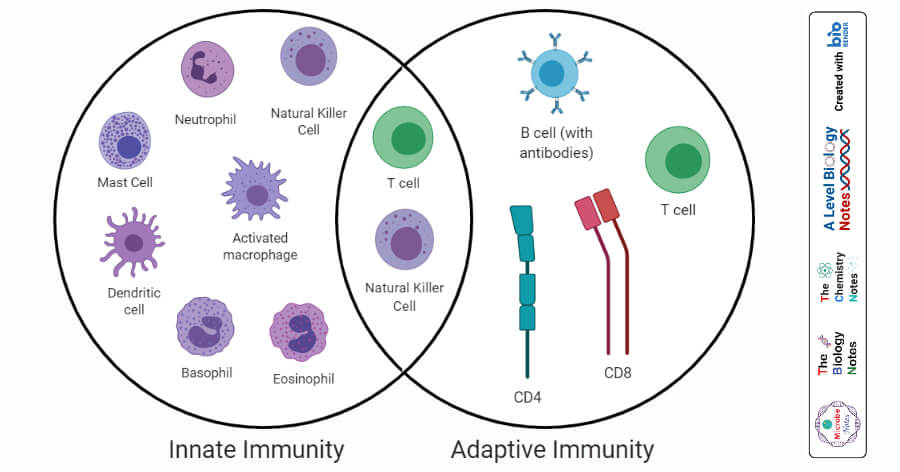
Interesting Science Videos
Some of the differences are:
|
S.N. |
Characteristics | Innate Immunity |
Adaptive Immunity |
| 1. | Synonyms | Nonspecific, natural immunity | Specific, acquired immunity |
| 2. | Definition | The defense mechanisms that are non-antigen specific and immediately come into play on the antigen’s appearance in the body. | The defense mechanism that is not always present but involve antigen-specific immune response. |
| 3. | Order of defense | It is the first line of defense of immune system. | It is the action against pathogens that are able to evade or overcome innate immune defenses. |
| 4. | State at birth | Presence since birth. | Acquired during lifetime. |
| 5. | Presence | Always present in the body itself. | Developed only upon exposure to antigens. |
| 6. | Inducible | No | Yes |
| 7. | Cells involved | Physical epithelial barriers, Phagocytic leukocyte, Dendritic cells, Natural killer (NK) cell, Mast cells etc. | Killer CD8+ T-cells, Helper CD4+ T-cells, B-cells, Antigen presenting cells etc. |
| 8. | Molecules involved | Cytokines, Complements ,Interferon, Acute phase proteins. | Antibodies
Cytokines |
| 9. | Fights against | Fights any foreign invader and thus is non-specific. | Ability to fight a specific infection. |
| 10. | Receptors involved | Uses receptors that recognize conserved pathogen-associated molecular patterns (PAMPs) such as LPS, flagellin, nucleic acids. | Uses recombined B- and T-cell receptors that recognize specific antigens on pathogens
|
| 11. | Effector function | Constitutive effective functions encoded in the germline (inflammation, phagocytosis) | Inducible effector functions (proliferation, activation, maturation, differentiation) |
| 12. | Response time | Occurs rapidly from minutes to hours. | Occurs over days to weeks. |
| 13. | Immunological memory | Does not confer memory | Confer immunological memory |
| 14. | Directed against | Innate immunity is directed towards types of molecules. | It is directed towards specific epitopes. |
| 15. | Subsequent exposure | The immune response does not alter on repeated exposure. | Immune response improves with each successive exposure. |
| 16. | Types of immune response | Types of adaptive immune responses: Inflammation, Complement mediated killing, Phagocytosis etc. | Two types of adaptive immune responses: humoral immunity, mediated by antibodies produced by B lymphocytes, and cell-mediated immunity, mediated by T lymphocytes. |
| 17. | Changeability | May vary between individuals but does not change over course of an individual lifetime | Immunity is generated by recombination of V, D, and J regions and further hypervariation thus may change. |
| 18. | Diversity | Limited | Diverse |
| 19. | Potency | Limited and Lower potency | Higher potency |
| 20. | Inheritance | Inherited from parents | Not inherited from parents |
| 21. | Time span | Once activated against a specific type of antigen, the immunity remains throughout the life. | The span of developed immunity can be lifelong or short. |
| 22. | Complexity | Innate immune response is less complex. | More complex than the innate immune response. |
| 23. | Anatomic and physiological barriers | Skin, Mucous membranes, Temp, pH, chemicals, etc. | Lymph nodes, spleen, mucosal associated lymphoid tissue. |
| 24. | Allergy or Hypersensitivity reaction | None | Immediate and Delay hypersensitivity |
| 25. | Complement system activation
|
Alternative and lectin pathways | Classical pathway |
| 26. | Found in | Found in nearly all forms of life. | Found only in jawed vertebrates. |
| 27. | Factors causing immune evasion | Caused by pathogenic virulence factor.
Often involves disabling the conserved pattern recognition used by innate system |
Caused by mutation of the recognized antigen. |
| 28. | Functions | a) Recruiting immune cells to sites of infection
b) Activation of the complement cascade to identify antigens c) Identification and removal of foreign substances present in organs, tissues, blood and lymph. d) Activation of the adaptive immune system through antigen presentation. e) Acting as a physical and chemical barrier to infectious agents. |
a) Recognition of specific “non-self” antigens during the process of antigen presentation.
b) Generation of responses that are tailored to maximally eliminate specific pathogens or pathogen-infected cells. c) Development of immunological memory, through memory B cells and memory T cells. |
| 29. | Examples | White blood cells fighting bacteria, causing redness and swelling during a cut. | Administration of Chickenpox vaccination such that an individual do not develop chickenpox as adaptive immunity forms immunological memory. |

What’s actually here is right